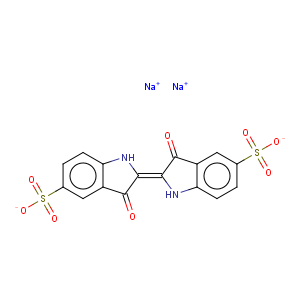Title: Indigo Carmine
CAS Registry Number: 860-22-0
CAS Name: 2-(1,3-Dihydro-3-oxo-5-sulfo-2
H-indol-2-ylidene)-2,3-dihydro-3-oxo-1
H-indole-5-sulfonic acid disodium salt
Synonyms: 3,3¢-dioxo-[D2,2¢-biindoline]-5,5¢-disulfonic acid disodium salt; disodium 5,5¢-indigotin disulfonate; sodium indigotin disulfonate; soluble indigo blue; indigotine; Acid Blue 74; C.I. Acid Blue 74; C.I. Food Blue 1; FD & C Blue No. 2; C.I. 73015
Molecular Formula: C16H8N2Na2O8S2
Molecular Weight: 466.35
Percent Composition: C 41.21%, H 1.73%, N 6.01%, Na 9.86%, O 27.45%, S 13.75%
Literature References: Synthesis and structure determination: Vorlander, Schubart,
Ber. 34, 1860 (1901). Prepn and properties: Matthews,
Color Trade J. 6, 96 (1920).
See also Colour Index vol. 4 (3rd ed., 1971) p 4597.
Properties: Dark-blue powder with coppery luster. Sensitive to light. Its solns have a blue or bluish-purple color. One gram dissolves in about 100 ml water at 25°. Slightly sol in alcohol. Practically insol in most other organic solvents. It is also marketed as a paste with water, the dye contents varying according to specification or requirements of the user. It almost always contains sodium chloride or sulfate used for "salting" it out. Indigo carmine is very sensitive to oxidizing agents. The color is readily discharged by nitric acid, chlorates, etc. The color of the aq soln fades on standing.
Use: Colorant for nylon, surgical sutures, foods and ingested drugs. As a reagent for functional kidney tests, for detection of nitrates, chlorates and in testing milk.

